
The unusual weather this winter has us guessing about what gardening tasks will be possible before the last frost. In the meantime, starting seeds indoors and shopping for orchids can satisfy the need to grow and admire plants.
Orchids have a reputation for being difficult to care for, but those that are comfortable in typical room temperatures require relatively little tending. Signage at the garden shops should say what conditions a particular orchid requires. On the internet, First Rays Orchids Free Information is a good place to learn more.
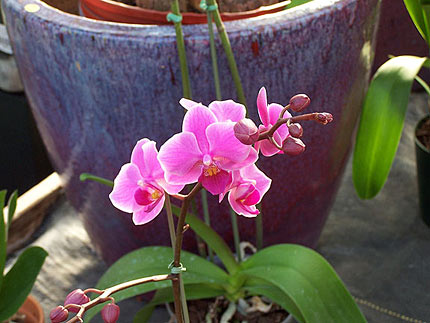
A Phalaenopsis orchid may be encouraged to rebloom by cutting back the stem to just under the first knuckle, where the last bloom fell off. A hot (sterile) cutting instrument will help prevent disease.
Not every orchid needs a tropical butterfly habitat. A windowsill with filtered sun for part of the day, and a grow-light to keep it warm on chilly nights, will be sufficient for the phalaenopsis and paphiopedilum hybrids commonly found in local garden stores. Many orchid guides suggest keeping a tray of wet pebbles under the pot to increase humidity.
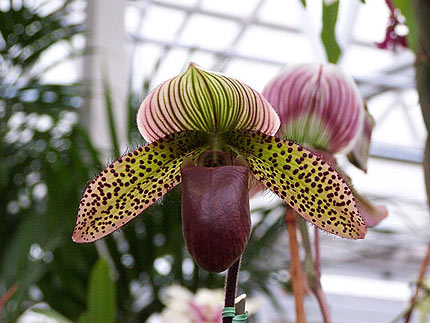
Paphiopedilum, "Lady Slipper"
The difficulty may take the form of restraint. Orchids may only need watering once a week, and feeding with very dilute plant food solutions once a month. A reminder from an electronic calendar is more appropriate than a wristwatch alarm. Water should go into the pot and not be poured over the plant as it can accumulate in the flower's chambers to the plant's detriment. The pot should drain completely. Orchid roots require moist, airy conditions, not a muddy swamp.
Orchids are some of the most prized flowering plants in the gardening universe. Difficulties may be overcome when a love affair with an especially fragrant or beautiful orchid inspires the necessary commitment to providing the habitat it needs.

Cymbidium
Peat pellets and peat pots make the process easier. The entire pot can go directly into the ground after the last frost. Soil from outdoors can be used if sterilized by baking for two hours at 180 degrees. Seeds of uncertain freshness can be tested by germinating a few between warm, damp paper towels. Most seed packets have basic directions printed on the back, and many seed providers provide detailed advice on their web sites.
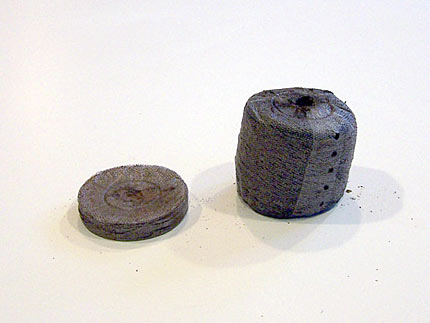
Peat pellet before and after expanding with warm water.
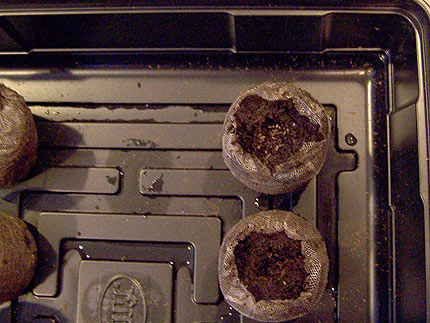
Expanded peat pellet with netting spread apart for sowing.
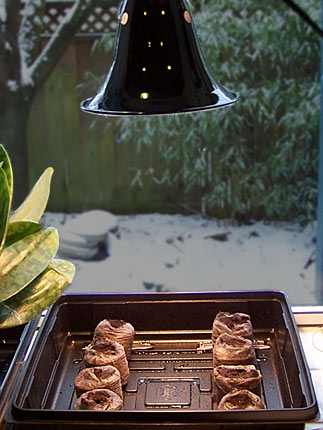
A grow light and a black tray help keep the little ones warm. Plastic wrap spread over the top and spoonfuls of warm tap water create a greenhouse effect.
Impatient gardeners can get fast and easy results with a growing kit such as SweetGreens® for cat grass, or a Wheatgrass Growing Kit for grass that can be juiced or added to a salad. Kits should be used promptly as they do not keep indefinitely. Seeds can sprout and start looking like grass in five days or less!
The Northwest Flower and Garden Show will be held from February 14 to 18, 2007 at the Washington State Convention Center in downtown Seattle. Orchid vendors from all over the world will have their most exotic specimens on display.
Molbak's in Woodinville, Washington, offers 20 percent off the price of a new orchid plant with the trade-in of a previously purchased orchid that has stopped blooming.
The vegetable and herb descriptions in the Territorial Seed Company catalog are enough to make a reader hungry! This Oregon company is listed in numerous garden resource directories.
Fragrant Garden is an Oregon company with experience growing Sweet Peas in the Northwest climate.
The Ed Hume Seeds web site provides excellent articles that explain in detail how to grow from seed, and common mistakes to avoid.
Renee's Garden is a familiar seed brand in local garden shops, and the web site offers abundant information to go with its products.
Monticello (yes, that Monticello) offers heritage seeds for sale with a convenient zone map and indices by both common names and latin names.
The Old Farmers Almanac has a chart showing typical last frost dates, and approximate number of days in growing seasons for eighty U.S. cities. It reports March 24 as the normal average date for the last freeze in Seattle.
A visit to an out-of-town nursery makes a nice day trip.
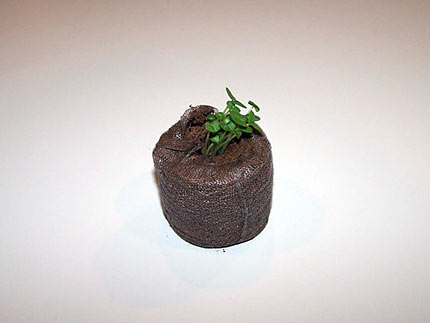
Basil seedling in peat pot
Return to Perspectives